The Loire Valley
As it glides gently east to west, officially separating northern from southern France, the Loire River has come to define this popular tourist region. Because of its history, this region is home to more than a thousand castles and palaces of all shapes and sizes. When a "valley address" became a must-have among 16th century hunting-crazy royalty, rich Renaissance palaces replaced outdated medieval castles. And it is castles that we came to see!
We chose Amboise as out home base for exploring nearby chateaux.
Amboise is an inviting town with a pleasing old quarter below its hilltop chateau. A castle has overlooked the Loire from Amboise since Roman times. Leonardo da Vinci retired here...just one more of his brilliant ideas.
We stayed at Hotel le Clos d'Amboise (see below), a restored 17th century chateaux with beautiful gardens and a small heating pool (kids loved it), stay-awhile lounges, a lovely terrace, well designed traditional rooms and an amazing farm to table restaurant (mom loved it).
Cheverny
This stately hunting palace is one of the more lavishly furnished Loire chateaux.This chateaux has been in the Hurault famiy since the start. The family still lives on the third floors (not open to the public, but we saw some family photos.) Cheverny was spared by the French Revolution; the count's relatives were popular then, as today, even among the village farmers.
We strolled through the I-could-live-here family apartments with silky bedrooms, kid's rooms, and an intimate dining room.
A short walk through beautiful gardens led to an orangerie. It was here that the Mona Lisa was hidden during WWII.
The viscount still loves to hunt and keeps 70 hounds in a nearby dog kennel. The dogs-half English foxhound and half French Poitou - are bred to have big feet and bigger stamina. Unfortunately, we missed the feeding show.
Chambord
With its huge scale and prickly silhouette, Chateau de Chambord, is the granddaddy of the Loire chateaux. It's surrounded by Europe's largest enclosed forest park. Six times the size of your average Loire castle, the chateau has 440 rooms and a fireplace for every day of the year.
The chateau's massive architecture is the star attraction - particularly the mind-boggling double-helix staircase. Right here.
Only 80 of the rooms are open to the public - but that's plenty, believe me! It helps that there is no one-way, mandatory tour route - you are free to roam like a duke surveying his domain.
And we finished our busy day back in Amboise in a low -key place -Restaurant L'Alliance-offering the kind of fresh, delicious French cuisine normally found in more formal restaurants. One of my best dining experience in France!
This! Every day! I loved the cheese course.
And dessert. Every single day. Sometimes twice a day.
Chateau de Chenonceau
Chateau de Chenonceau is the toast of the Loire! This 16th-century Renaissance palace arches gracefully over Cher River and is impeccably maintained, with fresh flower arrangements. And since it's the most-visited chateaus in France, we got up early to beat the crowd. First in line to get in!
Here is a proof.

We strutted like an aristocrats down the tree-canopied path to the chateau.

Once inside, we toured the chateaux and took the time to appreciate the beautiful brick floor tiles, lavishly decorated rooms and ceilings, tapestries, fresh flower decorations and more.
And we were done with our tour just before the hordes rolled in. We toured the two gardens with their postcard-perfect views of the chateau and took many pictures.


An idyllic way to savor graceful chateau views is to rent a rowboat. What a fun time!
To complete our aristocratic experience we had a lovely meal in a fancy Restaurant l'Organgerie behind the chateau stables.
Clos-Luce
Leonardo da Vinci's final home and gardens, with models of his creations.
In 1516, Leonardo packed his bags (and several of his favorite paintings, including the Mona Lisa) and left an imploding Rome for better wine and working conditions in the Loire Valley.
This "House of Light" is the push palace where Leonardo spent his last three years.
Two floors of finely decorated rooms are open to the public, but none of the furnishings are original, nor are they particularly compelling (though you can stare face-to-face with a copy of his Mona Lisa).
And back at Amboise for a nice dinner to finish off our busy day!
And one cannot visit France without going to a local farmer's market. This is what I miss the most! The cheese. The bread. The fruits.
A little Patisserie was more appealing than a long line at Chateau Royal d'Amboise.
This was an easy trade. We enjoyed two hours over un café, and a few desserts.
Chaumont-sur-Loire
A castle has been located on this spot since the 11th century; the current version is worth a visit, especially for garden and horse lovers. Festival of Gardens that unfolds next to the chateau every year, and modern-art lovers will enjoy how works have been incorporated into the gardens, chateau, and stables.
The stables were entirely rebuilt in the 1880s. See the art work bellow?
The estate is set in a 19th-century landscape, with woodlands and a fine lawn. More English than French, it has rolling open terrain, follies such as a water tower, and a brilliantly designed vegetable garden with an imaginative mix of edible and decorative plants. Its trees were imported from throughout the Mediterranean world to be enjoyed.
And that concludes are chateau hopping. We are officially "chateaux-holics!
What a fun week!
These world travelers were excellent this trip. Full of excitement and joy. My heart overflows!
After saying goodbye to this lovely place we headed back to Paris to continue our adventures.
On the way we stopped at Chartres to see its famous cathedral - arguably Europe's best example of pure Gothic. Chartres' old church burned to the ground in 1194. Some of the children who watched its destruction were actually around to help rebuild the cathedral and attend its dedication Mass in 1260. You do the math! That's quite astonishing!!! Having been built so quickly, the cathedral has a unity of architecture, statuary, and stained glass that captures the spirit of the Age of Faith like no other church.
Chartres' soaring (if mismatched) steeples announce to pilgrims that they've arrived. For centuries, pilgrims have come here to see holy relics, to honor "Our Lady", and to feed their souls. The right tower, with a Romanesque stone steeple, survived the fire. In the 1500s, it was topped with the flamboyant Gothic steeple we see today.
The place is HUGE - the nave is 427 feet long, 20 feet wide, and 120 feet high.
Notice the height of the entrance doors compared to the lovely tourists... the doors are 24 feet tall!
Rose windows through out.
This veil (or tunic) was supposedly worn by Mary when she gave birth to Jesus. It became the main object of adoration for the cult of the Virgin.
We circled around the back end of the church to enjoy its architecture, pondering the exoskeletal nature of Gothic design and the ability of medieval faint to mobilize the masses.
And this is it!
This trip was phenomenal!
Praising the Lord for His provision!!!


























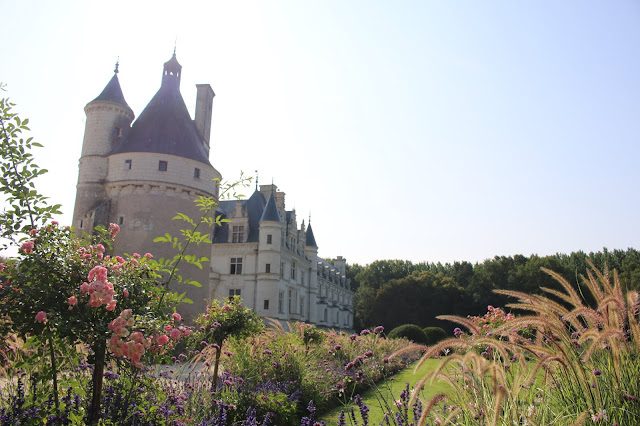
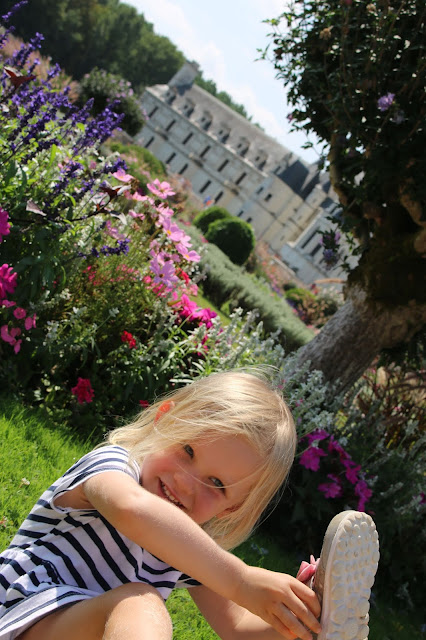






























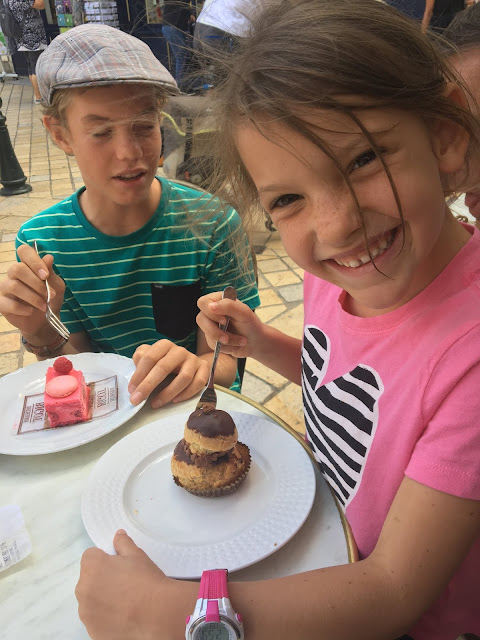





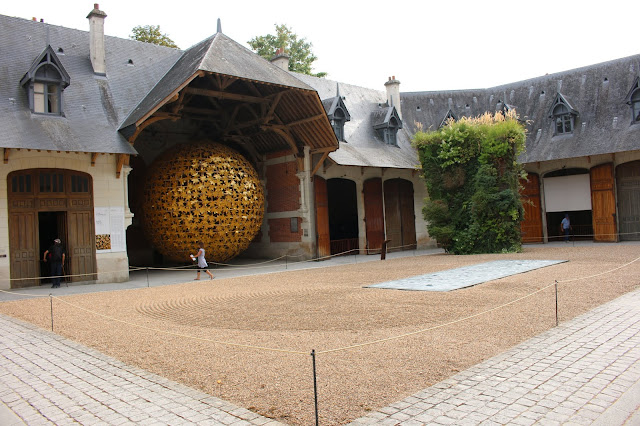









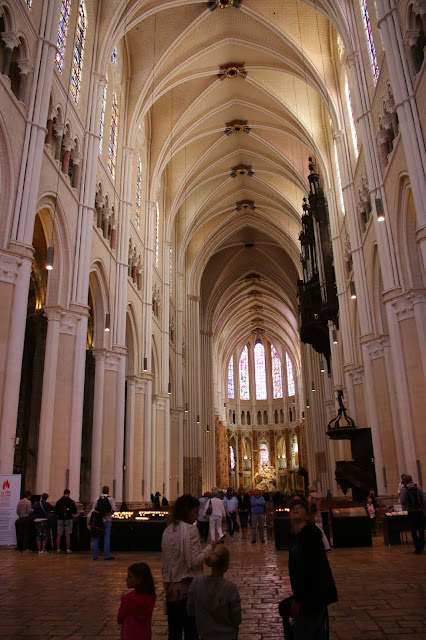









Love it! Thank you for sharing 😊 What amazing pictures of your beautiful adventure!
ReplyDelete